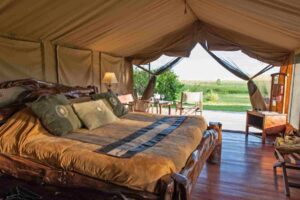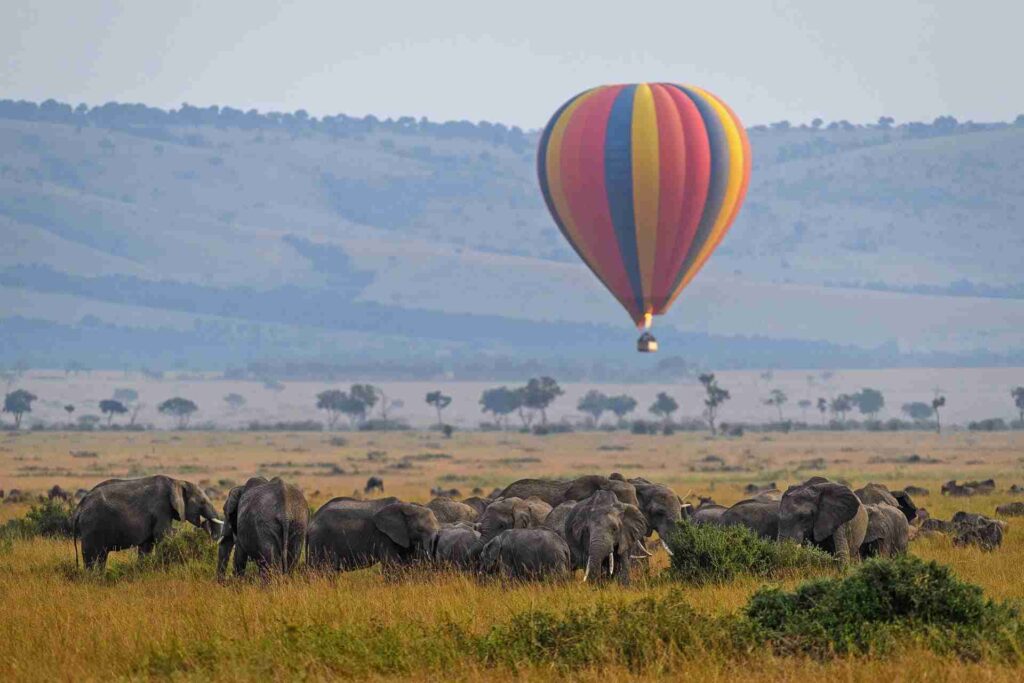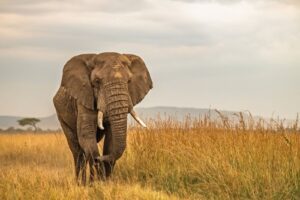Ever dreamt of witnessing the “Great Migration” firsthand, or even being surrounded by the Big Five in Mara Triangle conservancy? Naicef gives you an ultimate guide to Masai Mara conservancy camps, Mara conservancy fee and even an exposure of Mara conservancy map.
For a quick “Out of this World” safari package to this epic conservancy, reach Naicef via email my@naicef.com or call +254799922277.
We also give you the best of attractions in Nairobi, best conservancies and guide to all national parks in Kenya.
Are you ready for a jaws’ drop shock? You better be.
Did you know the Mara Triangle conservancy, offers one of the best Frontline views you could ever desire, to witness the Migration of the Mighty Blue Wildebeests.
Here you get to tick on your bucket list, of having encountered one of the 7 Wonders of the World. This is the annual migration of over 1.3 Million Wildebeests that normally happens between the months of June to October.
Below, is a more interesting story of this great conservancy!
Mara Triangle Conservancy History
The mara conservancy, was established in 2001 whereby the local Maasai people got concerned about the need for conservation measures. Dating back to the 1980s and 1990s, the conservancy faced challenges such as human-wildlife conflict and hence the Mara Conservancy was formed.
Over time, the initiative has proved successful motives of the local Maasai communities in Mara North in wildlife preservation.
Mara Conservancy Map
The triangular-shaped 500 square Kilometers conservancy in the southwestern region of Kenya, forms part of the famous Maasai Mara National Reserve. It borders Oloololo escarpment to the south, and the meandering Mara River to the North.
This pristine wilderness can be accessed by air and even via road. Via road the conservancy can be reached through the Oloololo gate via Aitong route or even, if accessed through Sekenani gate one may opt for Purungat Bridge.
The fastest means, one may consider taking a domestic flight from Wilson Airport to Mara Serena Airstrip. Below, is the Mara conservancy map in the Maasai Mara ecosystem;

Attractions in Mara Triangle Conservancy
1. Wildlife
The conservancy is among the best conservancies in Mara region, that habours many wild species. It is home to animals such as;
- Blue Wildebeest -best views are especially during the Great Migration
- The African Elephant
- Lion
- Leopard
- Cheetah
- African Wildcat
- Crocodiles
- Spotted Hyena
- Mongooses
- Serval
- Bat-eared Fox
- Blue Monkey
The conservancy is also a home to over 450 bird species entailing of the resident and the migratory ones. Some of these birds include;
Little Grebe, Common Ostrich, Dwarf Bittern, Grey Heron, White Stork, Sacred Ibis, Egyptian Goose, Secretary Bird.
2. Stunning Landscape
Being landmarked in a triangular shape, the conservancy is described by the acacia woodlands, rolling grasslands and the acacia woodland. It is bisected by the Mara River, famous for the great migration of the Blue Wildebeests, which is a Wonder of the World.
Are you a nature lover? Hell’s Gate National Park is yet another best place to explore the stunning rugged terrains and epic landscapes such as the Gorges and do rock climbing. The place is so famous that inspired the film “Lion King”.
3. Culture Enrichment
Mara Triangle is run by the local Maasai people, one of Kenya’s ethnic communities. The Maasai are a nomadic culture, known for their cattle herding and beautiful colorful clothing.
Their culture is distinctive and one of the most interesting tribes to interact and learn their customs.
Samburu communities are also one of the unique nilotic tribes also referred to as “The Butterfly People”. Check out also Namunyak conservancy, a community based conservancy managed by the local Samburu people and their tales of the “Singing Well”.
Things To Do In Mara Triangle Conservancy
1.Game Drives
Enjoy epic game encounters in an open-sided 4’4 Landcruiser with the help your Naicef guide as you explore the vast plains of the conservancy. Some of the wildlife one gets to see are such as Elephants, Lions, Hippos, Leopards, numerous Antelopes, Buffalos, Cheetahs.
2. The Wonder of the World
During the dry season, especially the months of June to October, over 1.3 million of the Mighty Blue-Wildebeests among other grazers, do migrate. This do happen as they cross the Mara river and move into and out of the .Masai Mara -Serengeti Ecosystem.
Mara Triangle conservancy, offers epic frontline views as these beings cross the river, readily awaited by the vicious Crocodiles to prey on them.
3. Bird Watching
Get to enjoy an immersive bird watch with the use of your binoculars and challenge yourself in spotting different bird species. The conservancy habours a wide array of birds such as Grey Heron, Secretary Bird, Sacred Ibis, White Stork, Egyptian Goose.
Lake Nakuru National park, is yet another bird’s paradise for bird lovers especially a haven for the Greater & Lesser Flamingoes.
4. Hot Air Balloon Safari
From game drives to nature walks, what better way can you get to explore a protected area rather than aerial views. Get to have a once in a lifetime moment as you explore this magnificent conservancy early in the morning, which is an opportune time.
The balloon safaris usually happens in the morning, a perfect time, when the animals are mostly active. Enjoy epic sunrise and see also the birds’ nests which are their laying grounds.
In seek of experiencing yet another aerial view safari? Worry not. Amboseli National Park is yet another pristine place to enjoy scenic views above the area and even of Africa’s highest mountain, Mount Kilimanjaro.
5. Guided Nature Walks
The conservancy allows visitors, with of course an expert guide, to explore the wilderness on foot and get to enjoy up-close views of different wild species.
Enjoying the on foot bond with mother nature? Ol Pejeta conservancy, home to the World’s only remaining two Northern White Rhino, is yet another best place where you can get to explore on foot.
6. Cultural Visit
Being a community owned conservancy, visitors do get optional visit to the Maasai villages and get to enjoy learning a new culture.
The Maasai people are among the tribes notable in Kenya and they do contain authentic customs that one may easily learn such as the traditional dances.
Mara Conservancy Fee
Below are the Mara North conservation fee;
a. High Season ( July to December)
Mara Triangle Entry Fee for Narok Residents
Adult – Ksh 2000
Child (9- 17 yrs) – Ksh 500
Students (in a group) – Ksh 300
Mara Triangle Entry Fee for Citizen
Adult – Ksh 3000
Child (9- 17 yrs) – Ksh 500
Students (in a group) – Ksh 500
Mara Triangle Entry Fee for East African Residents
Adult – Ksh 5000
Child (9- 17 yrs) – Ksh 2000
Students (Certified Conservation Clubs) – Ksh 300
Mara Triangle Entry Fee for Non Residents
Adult – USD 200
Child (9- 17 yrs) – USD 50
Students (in a group) – USD 50
a. Low Season ( Jan to June)
Mara Triangle Entry Fee for Narok Residents
Adult – Ksh 1000
Child (9- 17 yrs) – Ksh 200
Students (in a group) – Free
Mara Triangle Entry Fee for Citizen
Adult – Ksh 1500
Child (9- 17 yrs) – Ksh 300
Students (in a group) – Ksh 300
Mara Triangle Entry Fee for East African Residents
Adult – Ksh 2500
Child (9- 17 yrs) – Ksh 1000
Students (Certified Conservation Clubs) – Free
Mara Triangle Entry Fee for Non Residents
Adult – USD 100
Child (9- 17 yrs) – USD 50
Students (in a group) – USD 50
But remember that, for a person accessing the conservancy through the Sekenani Gate, do not pay the park fee until you enter the reserve at Purungat Bridge.
Masai Mara Conservancy Camps
The Masai Mara conservancy camps that are inside the triangle, are basically two which are, Little Governors’ Camp and Mara Serena Safari Lodge.

Some other luxurious and comfy accommodations that are outside but within the Mara Triangle, are such as;
- Kichwa Tembo Camp
- Angama Mara Lodge
- Kilima Camp
- Sanctuary Olonana
- Bateleur Camp
- Jacaranda Bush Camp
- Ahadi Mara Camp
- Pearl Mara Expedition
- Nyota Mara Lodge
- Mara Elatia Camp
Conclusion
Mara Triangle conservancy is a protected area particularly famous for it’s front views game encounters of different wild species. It is home to the Big Cats (Lion, Cheetah & Leopard), Elephants, Buffalos, Crocodiles, and the migratory Blue Wildebeests.
It is located in the southwestern area of the Mara ecosystem and be accessible via road through the Oloololo gate and air via the Mara Serena airstrip.
Mara North conservancy officially started operating in 2001, after the collaboration between the local Maasai people and conservationists professionals.
The Mara conservancy map, withholds one of the epic breathtaking landscapes and high populations of wild species. Some of the species include Large mammals such as Elephants, Lions, Wildebeests, Reptiles, numerous bird species.
Masai Mara conservancy camps are only two inside the conservancy but there are a few others outside the area.
Some of the fun things to do while in the conservancy are such as game views, bird watching, guided nature walks, hot air balloon safaris. This thus shows that every penny spent by paying the mara conservancy fee is worth it especially the majestic Great Migration.
With Naicef, get to experience this epic ‘Out of Africa’ safari and all you need is to book with us. Kindly reach us via email; my@naicef.com or just call +254799922277.
Naicef being the top leading tour company in Kenya offering luxurious safaris, is also considered as the best blog in Kenya & Africa.
Frequently Asked Questions (FAQs) About Mara Triangle Conservancy
1. What game views can one see in the Mara Triangle?
The conservancy habours a wide range of wild species such as Elephants, Leopards, Cheetahs, Blue Wildebeests, different bird species among others
2. How can one access the conservancy?
It can be accessed using the Aitong route via the Oloololo gate if it’s by road. Via air, it is best accessible through the Mara Serena Airstrip.
3. Are there accommodations within the Mara Triangle?
Yes, of course. The conservancy does entail two luxurious lodges inside and a few others neighbouring it.
4. What activities can one engage in, in the conservancy?
Visitors can enjoy epic game views, hot air balloon safaris, bird watching, cultural visits, among others.
5. Does the conservancy have fenced boundaries?
No, the Mara Triangle boundaries are marked by the Mara River, the Tanzania Border and the Oloololo escarpment.
6. How do i know that i have crossed over into Tanzania?
The Tanzania border is notable by white beacons.





